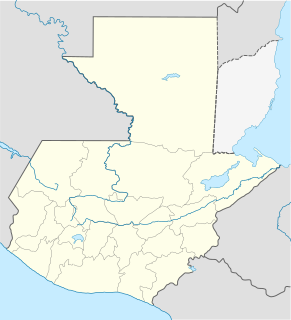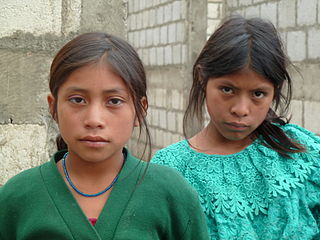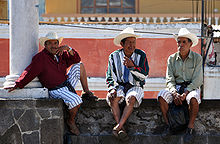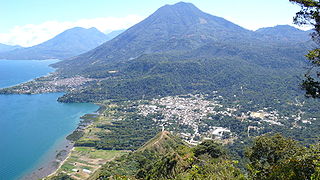
Alta Verapaz is a department in the north central part of Guatemala. The capital and chief city of the department is Cobán. Verapaz is bordered to the north by El Petén, to the east by Izabal, to the south by Zacapa, El Progreso, and Baja Verapaz, and to the west by El Quiché.
Kʼicheʼ are indigenous peoples of the Americas and are one of the Maya peoples. The Kʼicheʼ language is a Mesoamerican language in the Mayan language family. The highland Kʼicheʼ states in the pre-Columbian era are associated with the ancient Maya civilization, and reached the peak of their power and influence during the Mayan Postclassic period. The meaning of the word Kʼicheʼ is "many trees". The Nahuatl translation, Cuauhtēmallān "Place of the Many Trees (People)", is the origin of the word Guatemala. Quiché Department is also named for them. Rigoberta Menchú, an activist for indigenous rights who won the Nobel Peace Prize in 1992, is perhaps the best-known Kʼicheʼ.

Quiché is a department of Guatemala.

Lake Atitlán is a lake in the Guatemalan Highlands of the Sierra Madre mountain range. It is in the Sololá Department of southwestern Guatemala. It is the deepest lake in Central America

Maximón, also called San Simón, is a Mayan deity and folk saint represented in various forms by the Maya people of several towns in the highlands of Western Guatemala. Oral tradition of his creation and purpose in these communities is complex, diverse, and born of the ancient Maya traditions centuries ago.

Panajachel is a town in the southwestern Guatemalan Highlands, less than 90 miles from Guatemala City, in the department of Sololá. It serves as the administrative centre for the surrounding municipality of the same name. The elevation is 1,597 metres (5,240 ft). Population was 11 thousand in the 2000 census, estimated as 15,000 now (Insituto Nacional de Estadística de Guatemala), and has approximately doubled each of the last few decades. The town of Panajachel is located on the Northeast shore of Lake Atitlán, and has become a centre for the tourist trade of the area as it provides a base for visitors crossing the lake to visit other towns and villages.

San Pedro Solóma is a municipality of Huehuetenango, a department of Guatemala. It is located in the Sierra de los Cuchumatanes at 2,300 m above sea level. The municipality covers a total area of 264 km2 with elevations ranging from 1,900 m to 3,500 m. Its population of 47,688 people is spread over the town of Soloma, 19 villages and 50 smaller rural communities (caserios).

San Pedro La Laguna is a Guatemalan town on the southwest shore of Lake Atitlán. For centuries, San Pedro La Laguna has been inhabited by the Tz'utujil people, and in recent years it has also become a tourist destination for its Spanish language schools, night life, and proximity to the lake and volcanos.

Santa Cruz La Laguna is a municipality located on the northern shore of Lago de Atitlán in the Sololá department of Guatemala. It consists of the villages of Santa Cruz La Laguna and Tzununá as well as four smaller villages (caseríos). As of 2018 the estimated population is 9,392 people and the area is populated almost entirely by the Kaq'chikel indigenous Maya people.

Santiago Atitlán is a municipality in the Sololá department of Guatemala. The town is situated on Lago de Atitlán, which has an elevation of 5,105 feet (1,556 m). The town sits on a bay of Lago Atitlan between two volcanos. Volcan San Pedro rises to 2,846 metres (9,337 ft) west of town; Volcan Toliman rises to 3,144 metres (10,315 ft) southeast of town. Volcan Atitlan, with a summit of 3,516 metres (11,535 ft), is south-southeast of town. Santiago Atitlan is southwest of Panajachel across the lake. Major highways reach Lago Atitlan at San Lucas Toliman and Panajachel. A road links Santiago to San Lucas Tolliman. Boats connect the numerous communities around Lago Atitlan.
The Kaqchikel language is an indigenous Mesoamerican language and a member of the Quichean–Mamean branch of the Mayan languages family. It is spoken by the indigenous Kaqchikel people in central Guatemala. It is closely related to the Kʼicheʼ (Quiché) and Tzʼutujil languages.
Panabaj, located on the edge of Lake Atitlán in the western highlands of Guatemala, is a small village within the municipality of Santiago Atitlán, bordering the city of Santiago Atitlán proper, in the department of Sololá. Prior to the disaster of Hurricane Stan in which over 400 persons from Panabaj and nearby Tzanchaj were killed or left missing, the town's population had numbered over 3,000, though a census has not been taken since.

The Mam are an indigenous people in the western highlands of Guatemala and in south-western Mexico who speak the Mam language.
Tzʼutujil is a Mayan language spoken by the Tzʼutujil people in the region to the south of Lake Atitlán in Guatemala. Tzʼutujil is closely related to its larger neighbors, Kaqchikel and Kʼicheʼ. The 2002 census found 60,000 people speak Tzʼutujil as their mother tongue. The two Tzʼutijil dialects are Eastern and Western.
The Chʼortiʼ people are one of the indigenous Maya peoples, who primarily reside in communities and towns of southeastern Guatemala, northwestern Honduras, and northern El Salvador. Their indigenous language, also known as Chʼortiʼ, is a survival of Classic Choltian, the language of the inscriptions in Copan. It is the first language of approximately 15,000 people, although the majority of present-day Chʼortiʼ speakers are bilingual in Spanish as well.
The Guatemala Health Initiative (GHI) is a private, humanitarian organization that works to improve the health of the poor, indigenous population in the remote areas of the western highlands in Guatemala. (Penn) faculty, students, and staff work in partnership to serve the health issues of the underprivileged Santiago Atitlán community in Guatemala. The goal of GHI is to strengthen clinical services and promote community health in resource-poor Guatemalan communities.

Paula Nicho Cumez is a Mayan-Guatemalan artist. Cumez is inspired by Mayan tradition and culture and focuses on expressing the context of native women’s experience in her artwork; additionally, Cumez was inspired by the Popol Vuh. Cumez is known for creating an artist community of women within the Tz’uthil Mayan artists, named "Kaqchikel Surrealist Painters.” Additionally, a short film was made about Paula Nicho Cumez’s background called Del Azul al Cielo.






















